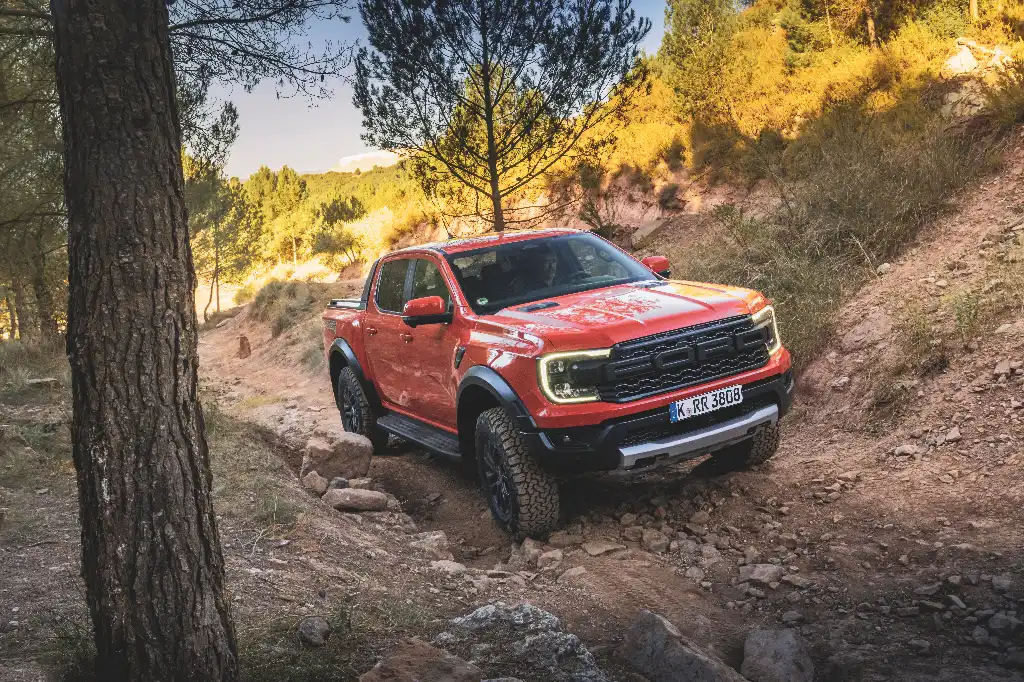
The Ford Ranger Raptor has been a runaway success, with sales far greater than anyone could have imagined for a pick-up truck that is both heavy and expensive. One in 20 sales in all of Europe were for the Raptor version of the Ford Ranger and one in three sales across Europe of all pick-ups were a Ford. But it's the introduction of a V6 powertrain that is really going to set the Ford Ranger Raptor apart, find out why in this review.
A new 3-litre V6 turbocharged petrol engine is the headline grabbing engine for the Ranger Raptor. While it doesn't replace the 2-litre diesel engine which has already been such a success for Ford in the Raptor, it will effectively usurp it as the engine of choice. And with very good reason too.
The 3-litre petrol EcoBoost V6 produces 289hp with 491Nm of torque. That totally shames the 210hp of the 2-litre diesel and almost matches its 500Nm for power. You can of course still get the 2-litre diesel but keep reading the Ford Ranger Raptor review to find out why it's the petrol engine you'll want.
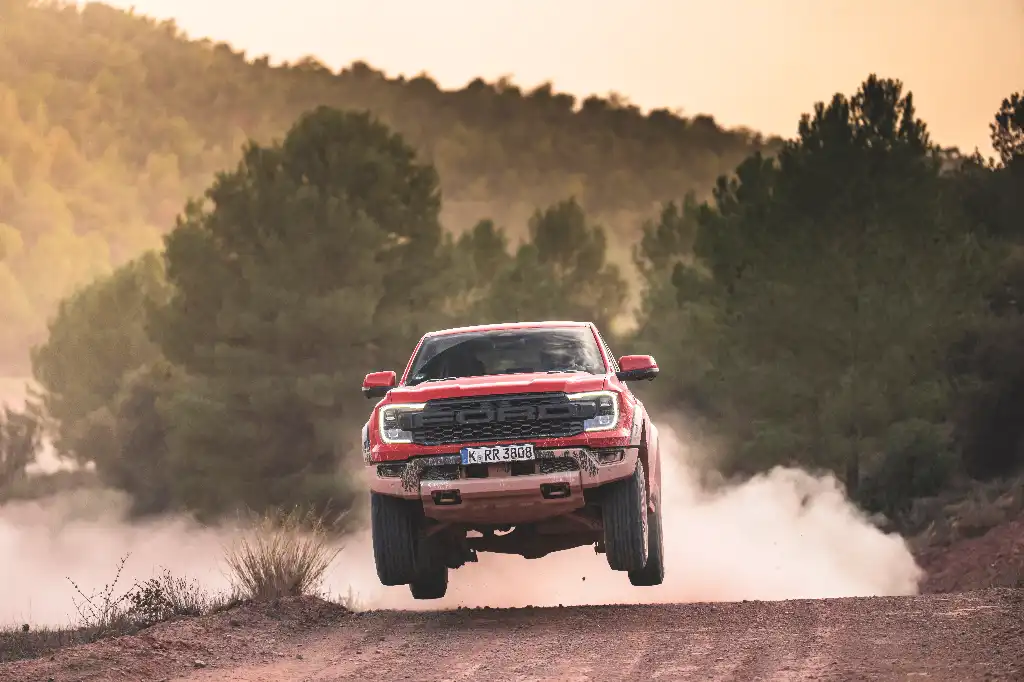
Apart from a lot of power, the new range-topping V6 is the first petrol engine to arrive in the European Raptor. While it's still not as ludicrous as the V8 of the US spec Ford F150 Raptor the V6 petrol more than delivers for the smaller Ranger Raptor.
The twin-turbo 3-litre uses a new anti-lag system that keeps pressure in the turbochargers for up to three seconds so that power can quickly be restored. That means that if you back-off the throttle, for example when entering a corner, you can pick up the power a lot faster as you accelerate out of it as there's still pressure in the turbo. This is done through a valve that closes when the accelerator is lifted. It’s an anti-lag system that’s been deployed with great success in rally cars. And oh boy does it work well.
The engine itself has also been made to be really tough with a graphite-iron cylinder block that is said to be 75% stronger and stiffer than the iron used in a regular engine. This is all down to the work of Ford Performance, the Australian development team that designed and tuned the previous Ranger Raptor.
Power is delivered through the same 10-speed transmission used on the previous Ranger Raptor and available on the regular Ranger. The new engine, however, is programmed with unique turbocharging boost profiles depending on the gear. That means that no matter which gear you're in, the Ford Ranger Raptor is ready to give you maximum boost when you floor the accelerator.
Yes. Hell yes. It sounds brilliant. But there's more to the Ranger Raptor's exhaust note than a set of noisy pipes. The Ford Ranger Raptor has an adaptive exhaust note system called Active Exhuast Valve. That means you can sound like a hooligan in Sport or Baja mode while also not pissing off the neighbours with its Quiet setting. There's also a Normal mode for everyday use where the exhaust sounds good, but not over the top. Sport setting increases the noise level, while Baja makes the exhaust sound like a straight-through system.
The Raptor warns you that Baja exhaust mode is only for off-road use, but you can easily change the exhaust setting with a steering wheel-mounted button for maximum noise when you need. We’re sure many buyers will do just that.
There's even a Raptor "R" button for activating your preferred settings with one quick press. This can also include changing the steering and suspension settings.
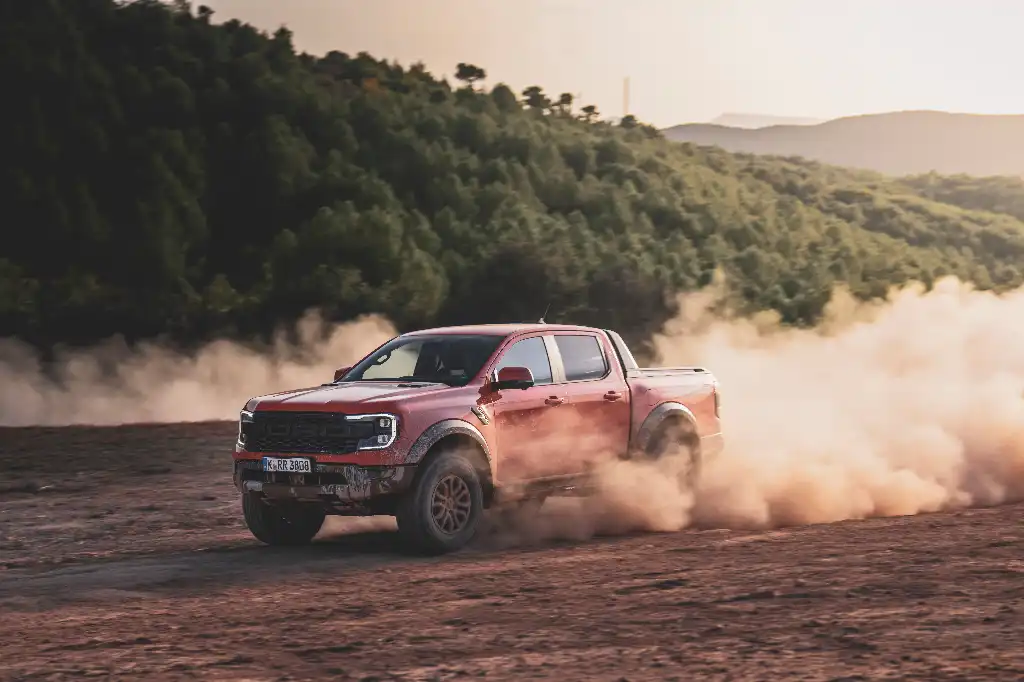
Just a bit. In fact, the Raptor suspension is like nothing you've ever seen before on an off-the-shelf pick-up. If you've driven the first Ranger Raptor you'll know all about the Fox racing shocks that were fitted. There are clever dampers that stiffen up at the lower end of their travel to allow the Raptor to absorb massive levels of abuse.
The latest Fox 2.5-inch Live Valve dampers are an upgrade to the already brilliant suspension. They provide position-sensitive damping, which means the Raptor is even more comfortable on the road but able to endure far greater levels of impact. The new design increases what Ford engineers call the dampening authority by 3000Nm between being fully hard and fully soft.
A Ford engineer explained it brilliantly giving the example of a slide hammer. When you drop the weight, it quickly falls and slams when it stops. The Live Valve allows that initial fast drop, but then image there is some soft cushioning foam. This soaks up the abuse at the extreme ends of travel.
It also has new lightweight aluminium upper and lower control arms with longer travel for the front suspension.
Pick-up trucks often suffer from a shallow bouncing sort of feeling. It's a characteristic of their body on frame design, long wheelbase and usually leaf-sprung rear axle. The Ford Ranger Raptor has none of that.
On the road the Ranger Raptor rides like a magic carpet over the Arabian sands. The previous model was good at this, but it could still feel a little wallowy and nodded a bit at the front end. The new suspension improves the overall ride quality and eliminates any feeling of bounce because of an increase in rebound dampening at the front.
The 10-speed gearbox is exceptionally fast and smooth with its gear shifts. It's similar to the transmission used in the Ford Transit van except that the Raptor comes with aluminium paddleshifters mounted behind the steering wheel.
For those people with any experience of the Ranger and the Ranger Raptor you'll notice the massive improvement in the handling.
The previous Ranger Raptor had to alter the steering ratio from the previous Ranger base-model making it feel a bit more cumbersome when cornering. You needed to put more turn in, to get the same trajectory out of the corner.
The latest Ford Ranger Raptor has an increased steering ratio which is now the same as the base Ranger. If you're interested in the numbers the previous Raptor had an 18.6:1 ration, but the latest Ford Ranger Raptor has a 17.6:1 ratio.
The result is that it turns in really sharply, and is far more accurate and direct. Smaller inputs are translated to quicker actions at the wheels and because of that the Ranger Raptor feels a lot more responsive, agile and nimble. It's a benefit felt across all terrains but is especially noticeable on the road where the Ranger Raptor has become effortlessly easy at driving fast. Better handling and more power makes it a really dynamic vehicle to be in, considering its size.
How long have you got to hear about how good this thing is? We could talk about it all day long.
We'll keep it short, though. For now.
The Ranger Raptor is so good off-road it will make you question the laws of physics. A pick-up truck this big should not be able to climb 30-degree rock faces this easily. It is off-roading witchcraft. No direct from the factory pick-up truck can even come close to matching its abilities.
For added robustness when off-roading the Raptor has a 2.3mm high-strength steel bash plate fitted as standard. This is almost double the thickness fitted on the previous model and the latest Ford Ranger which has a 1.4mm plate.
The enormous amounts of suspension travel allows the Raptor to pretty much always find a surface to grip onto. It has a total of 256mm of travel at the front with 135mm in compression, up 20mm from the previous model, and 290mm of travel at the rear. Even if the suspension can't quite reach the ground, there are plenty of tricks available to help out.
The most important is the now standard front and rear locking differentials. These will help you get out of almost any situation. But before you might even need to engage the diffs, the comprehensive off-road settings will be working hard to keep you moving.
On the road there are Normal, Sport and Slippery settings, but off-road you get four more. Rock Crawl does what you'd expect and is for very slow uneven ground. Sand changes the gearbox settings for fast changes and quicker power delivery in soft surfaces like sand and snow. The Mud/Ruts setting enhances grip and automatically engages the rear differential, and then there's Baja.
The Baja setting became legendary on the first Raptor, and with good reason.
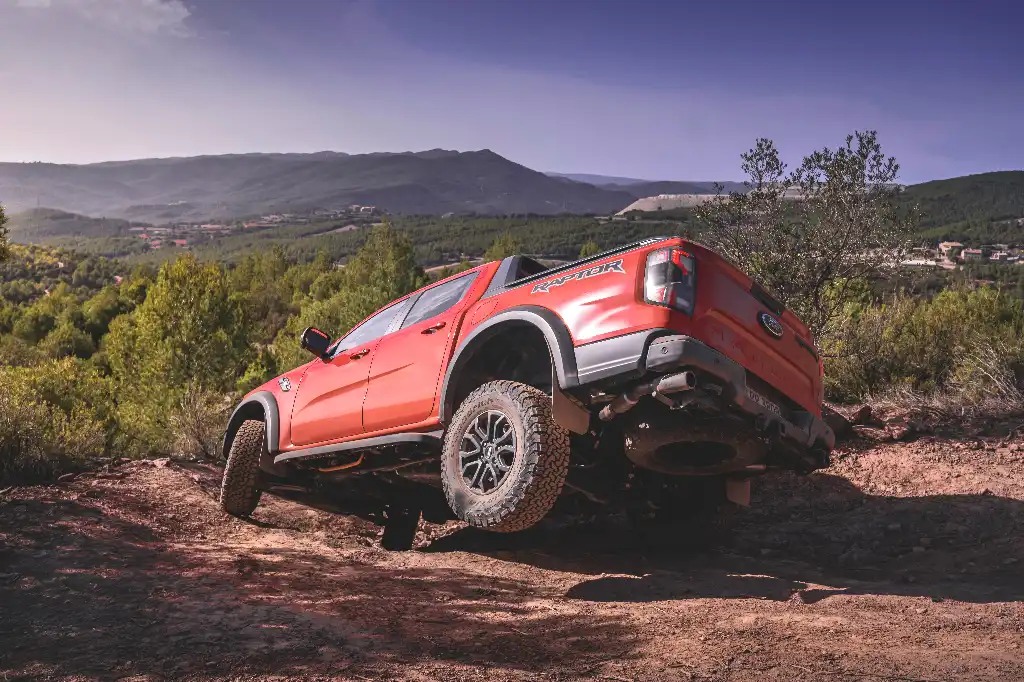
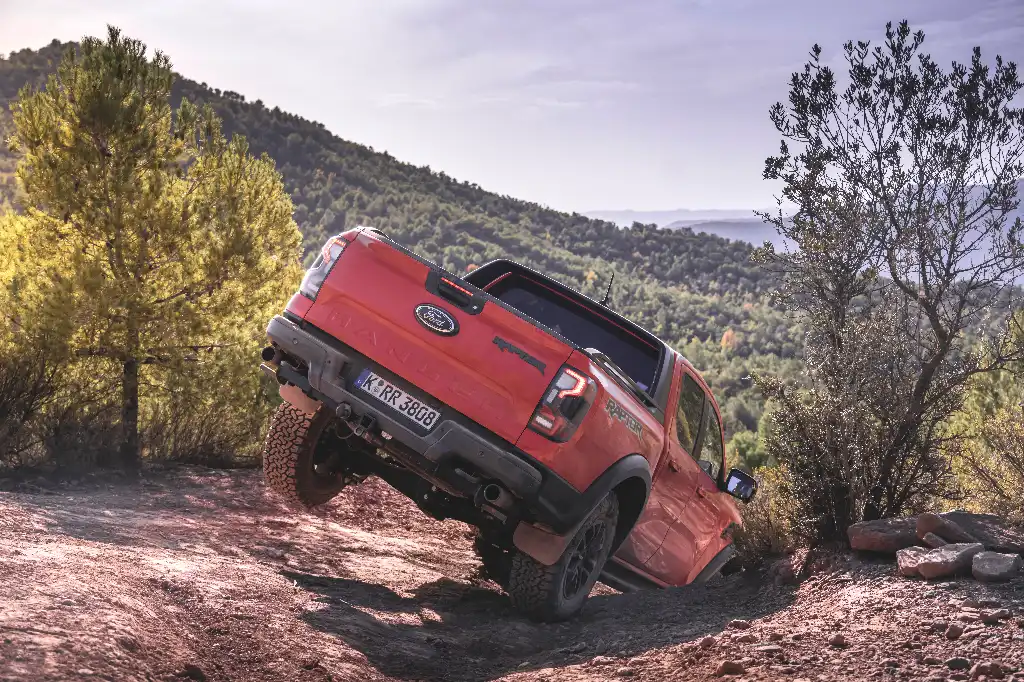
Named after the epic desert races, Baja mode in the Ranger Raptor lets you feel like a driving hero on sand or other slippery surfaces while still giving you enough assistance systems to keep you safe.
Not only does it automatically turn the exhaust note to high, it also softens the dampers to let you really maximise the Fox dampers to attack the terrain with maximum speed. It's a sports mode turned up to 11, and delivers the most fun you can have in a pick-up.
Yes there is, although it isn't called cruise control. It's called Trail Control and appears as an option on the touchscreen when in one of the off-road settings (Rock Crawl, Sand, Mud/Ruts or Baja).
It is though, just like regular cruise control - which the Ranger Raptor also has - except it works at very specific speeds.
Less than 32 km/h (20mph) in two-wheel drive high (2H) or four-wheel drive high (4H) modes.
Less than 15 km/h (9mph) in four-wheel drive low (4L) mode and less than 8 km/h in reverse (R).
It can also go as low as 1.5km/h or 1mph and it works on all terrains, including when going downhill.
The latest Ford Ranger Raptor is 50mm wider than the current model. That sounds like a lot but it's been increased for a variety of reasons. Ford has re-engineered the suspension placing the dampers beyond the frame of the vehicle for better ride comfort and performance. In making it wider they've also increased the capacity of the load bed. That means it can now accommodate pallets or sheets more easily.
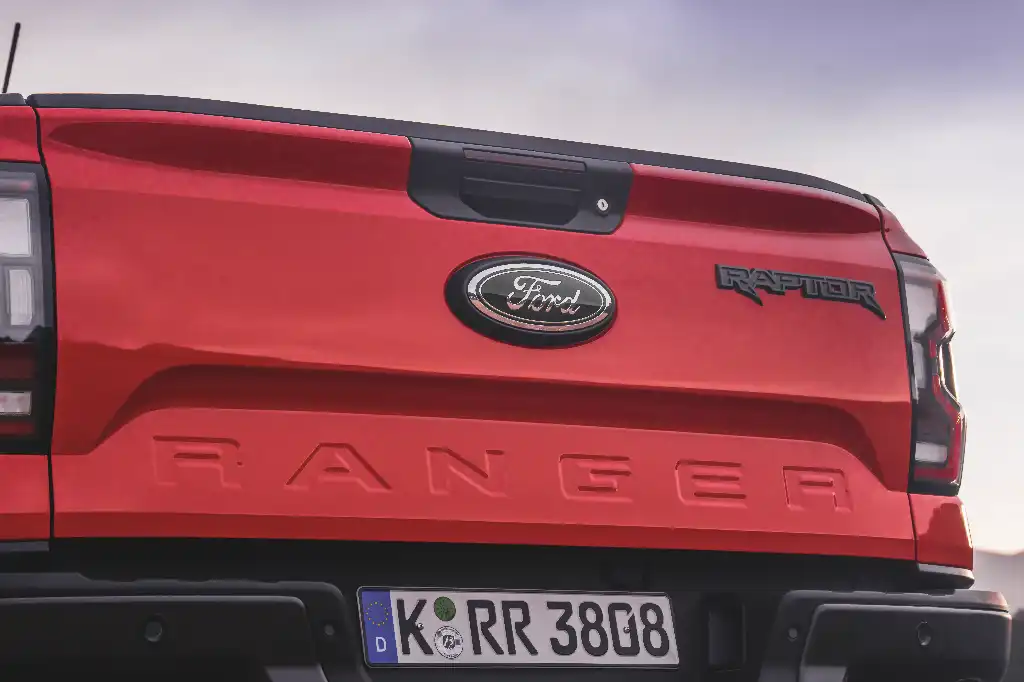
The most obvious difference is at the frond where there are now so-called C-shape daytime running lights. They make for a very distinctive appearance and help frame the big, wide grille where the F-O-R-D lettering is so prominent.
The large wheelarches remain, although redesigned, and at the rear there's the very obvious Ranger stamp on the tailgate as well as having a new spoiler-like lip.
Less obvious is the change to the wheelbase. The Ford Ranger Raptor has got longer between the wheels. The front wheel has been moved further forward by 50mm, increasing stability, improving handling and making the front overhang a lot shorter. That improves it's off-road ability with an increase in the maximum possible approach angle.
There aren't all that many options you can throw at the Raptor because it already has nearly everything on it.
One obvious addition are the splash decals that add a camo style look to the rear of the truck.
You'll have more luck adding accessories to the pick-up. The most notable add-on is a roof-mounted two person tent that can be ordered through the dealership. Made by ARB, the tent has a built in mattress, five windows and zippered insect screens.
Inside, the Ranger Raptor gets a redesigned dash with new materials and a new cut-down “e-shifter” gear selector with electronic parking brake.
The Code Red coloured accents around the air vents, on the seats and stitching on the steering wheel and e-shifter adds some colour to the cabin, but its the 12.4-inch centre touchscreen that is the heart and soul of the raptor. While it controls all the usual infotainment and navigation systems you'd expect - and is linked to a powerful and crystal clear B&O 10-speaker sound system - it also becomes the control centre when off-roading. Switch to various off-road modes like Rock Crawl and the screen shows you the settings for the driveline. It is here that you activate the front and rear locking differentials.
There’s a fully digital 12.4-inch instrument cluster as well that enables the drivers to customise their view with information from navigation to thepitch angle of the vehicle. It also shows other relevant data for the six new driving modes (similar to those found in the current Ranger Raptor) that are programmed into the touchscreen.
For safer off-roading and easier parking, the Raptor also has a 360-degree camera view function. The view can be toggled betwen front and rear cameras while off-roading to see what's happening at ground level.
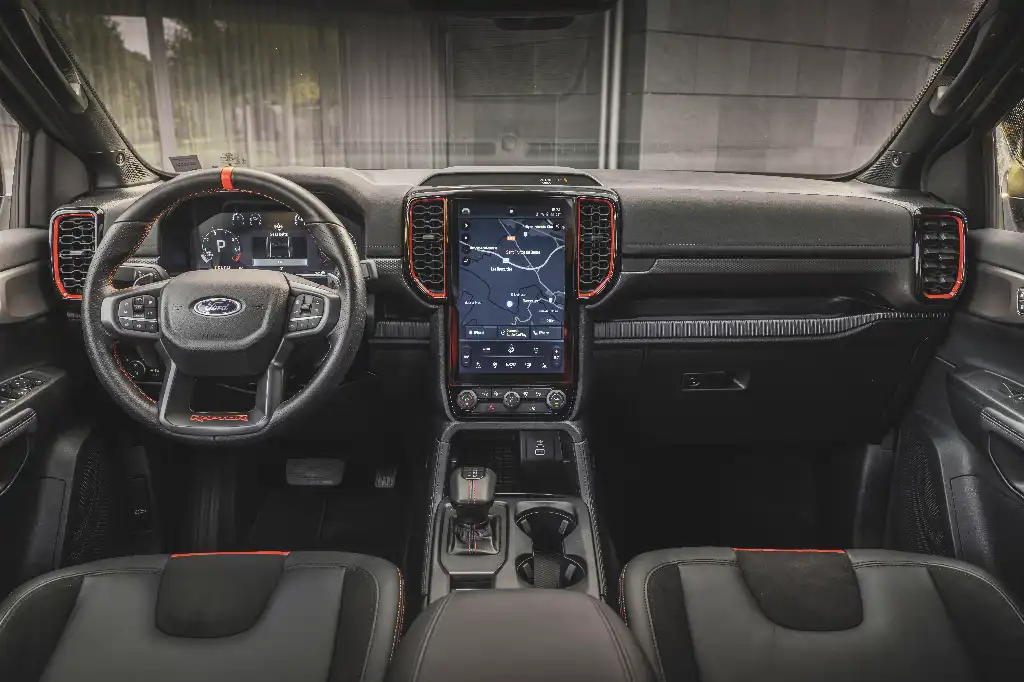
A stubby e-shifter gear selector sits next to two cupholders in the transmission tunnel, and just ahead of the drivetrain selector used to access the various driving modes as well as pick between Four Low, Four High and Two High – a 4A or ‘four automatic’.
In front of that in the lower centre dash console there's another storage space and a wireless charging pad. There's a single standard USB connector and a USB-C in the same area too.
Less obvious, but a fantastic feature, are the row of rocker switches on the Raptor’s roof panel. There's six in total and these can be used for controlling pre-wired circuits. There are two switches for wires to the front, two for the roof and two for the rear. They're there to make it easier to plug in powered accessories.
One of the big downsides to Raptor ownership is that it is heavy. The Ford Ranger Raptor weighs 2454kg with a payload of 652kg. That's a dramatically reduced payload to a regular Ranger. In the UK that also has the knock-on effect of making it not eligible for a VAT refund for commercial use. Effectively, it is a passenger car, rather than a pick-up.
Aside from the weight issue, the Raptor is just as versatile and useful as a regular Ranger. There are neat new details like an onboard measuring ruler and cut-outs to let you use clamps on the tailgate. There's also a 400W onboard inverter, flexible cargo dividing system and protective plastic capping to protect the bodywork.
The Ranger Raptor has even got an 850mm wading depth, so it's capable of doing all sorts or tasks - even really watery ones.
Now there's a big question that can't yet really be answered because so much of the Ford Ranger Raptor is brand new. However, judging by the issues being experienced by current Ranger owners there's really nothing to worry about.
There have been some reports of surface rusting on Ranger chassis and Ford has made provisions to correct these, and going forwards no new Rangers should experience the problem. The Ranger Raptor will also get the same treatment.
A powerful V6 engine with twin turbos would ordinarily be an area of concern, however, despite having 289hp it is likely to be well below what this block is capable of. Ford has ample experience
No, sorry the Ford Ranger Raptor is definitely not a commercial vehicle when it comes to tax puproses in the UK.
All the clever suspension means that the Raptor's hefty kerbweight limits its payload capacity. The 652kg payload falls well short of the required 1-tonne payload in order to claim the VAT back for commercial use and get the flat-rated commercial vehicle road tax.
As a result Ford Ranger Raptor buyers will have to pay the full VAT and fork out for the CO2 related road tax and the expensive car additional tax for vehicles over £40,000.
In a perfect world where the environment and sustainability is no longer an issue and money is no object, the answer is without a doubt, yes!
The Ford Ranger Raptor truly is the most complete and remarkable pick-up truck.
A V6 petrol will of course be expensive to run, and buying it isn't cheap either. The launch list price is £48,300 and balloons to £57,960 once you've got it on the road and added the VAT.
Purely as an on-road pick-up truck it's probably hard to justify the expense, if however, you do go off-road and are able to enjoy just a fraction of the Raptor's potential it beats all other pick-ups hands down.
The Ranger Raptor is Ford's finest work to date. It showcases its brilliant engineering and technology and delivers on every front. Comfortable on-road, jaw-dropping off-road. The Raptor is not just a performance pick-up it is a pick-up that performs, wherever you try to take it.

| Ford Ranger Raptor Dimensions | Millimetres (mm) |
|---|---|
| Overall length | 5360 |
| Overall width with/without mirrors | 2208/2028 |
| Overall height | 1926 |
| Wheelbase | 3270 |
| Ground clearance | 265 |
| Wading depth | 850 |
| Front track | 1710 |
| Rear track | 1710 |
| Front Overhang | 865 |
| Rear Overhang | 1225 |
| Angles | |
| Approach angle | 32 degrees |
| Departure angle | 24 degrees |
| Breakover angle | 24 degrees |
| Cargo bed | Millimetres (mm) |
| Max width | 1224mm |
| Depth | 529mm |
| Length | 1594mm |